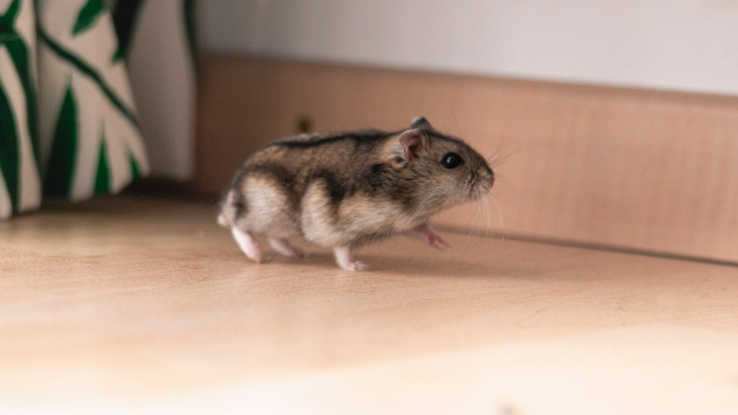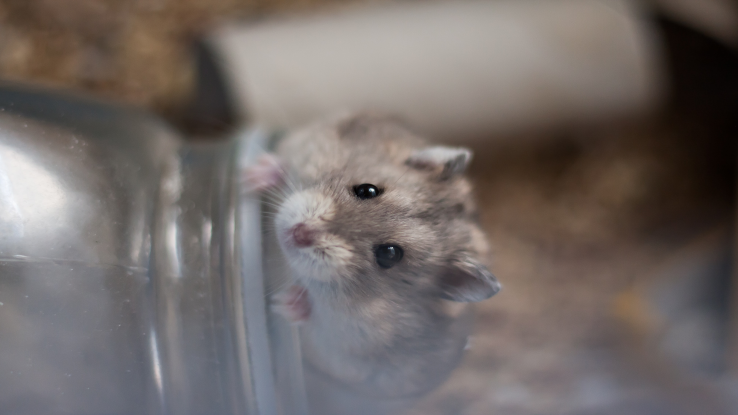3 Month Old Budgie How Do I Feed and Water One in Cage
Other than food (and maybe a partner), housing is going to be the most important thing you give your hamster. After all, this is the place where they will burrow, dig, climb, scratch, eat, sleep, and go potty. Just as your home is your castle, a hamster's cage is theirs.
As such, you want to make sure that you pick out the perfect place for your hamster to call home. If you've already been looking around, you know there are a lot of options to choose from. We're here to help you sort through it all with our comprehensive guide to hamster cages.
Factors to Consider

Hamster cages aren't a one-size-fits-all purchase. There are essential factors that must be considered to ensure that you make the right investment. Let's stroll through these together so you know precisely what to look for in your journey through hamster housing.
Size
Cheap hamster cages are a dime a dozen these days. The problem is that these cages are often small and confining. Your hamster is like most other creatures; it needs plenty of room to stretch its little legs and get the exercise required for a healthy and happy life.
While many people think that a running wheel is all that's needed for exercise, hamsters need room to dig, burrow, and explore. As such, you should consider investing in a larger cage that affords plenty of room for play and activity.
With that said, there are some contingencies you have to consider. We'll discuss those in a moment. But for now, look at your options and go with a cage that accommodates your hamster's needs.
It's important to note that smaller hamsters, such as the diminutive dwarf hamster, may not require as much living space as their larger cousins.
A Syrian hamster, for example, should be in a cage no smaller than 24 x 12 inches. You should also try to go with heights no shorter than 12 inches. While it's true that hamsters need floor space more than anything, you will have an easier time with attachments and interior items by sticking to a minimum of 12 inches tall.
Levels
You can maximize your hamster's room in their cage by choosing one that offers more than one level. Many hamster cages are designed with steps or chutes that allow your pet to explore multiple floors.
Granted, the cost is typically more. But your hamster will have a home that provides them with plenty to see and do, ensuring a happier lifestyle. And if you plan on adding another hamster or two later, you'll have the extra room to do so.
Type
Some hamster owners prefer a traditional cage, while others go for a glass tank. Both housing options give hamsters a secure place to thrive. However, the cost usually increases significantly when you choose glass.
Not only that, but glass tanks – especially larger ones – are pretty heavy. If you're trying to keep your out-of-pocket expenses to a minimum, a traditional cage is likely to be the best option.
What's more, you'll have a much easier time adding on new components if you ever need to upgrade. Many hamster accessories are designed to snap onto cages, as well.
You also have to think about the breathability of cages. Compared to glass tanks, cages offer better ventilation and are less of a safety hazard in this area. If you opt for a glass tank, you will need to make sure that the lid allows for plenty of airflow while still being able to keep your hamster from escaping.
Additionally, you will need to carefully inspect your hamster cage to make sure there are no areas that could pose a threat to your furry friend. The smallest piece of metal sticking up could potentially injure your pet, so it's best to give your hamster's home a thorough once-over before putting them inside.
Different Hamsters, Different Cages

As we just discussed, the best cage size for a Syrian hamster is at least 24 x 12 inches, with a one-foot height. Syrian hamsters are territorial creatures that value their privacy to their detriment. Try placing a "friend" in a Syrian hamster's cage, and the results likely won't be pretty.
So if you're planning to eventually buy more hamsters, you'll want to avoid the Syrian breed. Dwarf hamsters, on the other hand, enjoy one another's company as long as you maintain the proper ratio of hamsters to cage size.
A dwarf hamster by itself can do splendidly in a cage 18 x 10 inches (and a 12-inch height). But if you adopt two dwarf hamsters, you'll need to bump your cage size up to that of a Syrian, 24 x 12 inches. For each additional hamster that you add to the mix, you'll need to increase your cage size.
Even if you don't think you'll want another hamster, it's probably best to go a little bit bigger. You may find that you later want to give your pet some company. Some hamsters thrive when they have another of their kind around, so you'll want to explore their history to determine if friends are a good idea.
Types of Cages

Believe it or not, there is actually more than one type of hamster cage. The most common type is the wire cage. These are the models that look like tiny jails, with vertical bars lining the cage. You'll want to pay close attention to the spacing of the bars, however.
Hamsters have the amazing ability to flatten their bodies down to incredible sizes. If there is an opening no bigger than your hamster's skull, it'll be able to fit through it with little effort. Remember, that's the skull, not the ears, fur, or cheeks.
Those are inconsequential when a hamster is squeezing through gaps and openings. As such, you'll want to compare models until you find the best one to accommodate your hamster.
As a brief aside, some hamster cages have bars along the floor, with a plastic tray that rests underneath. Although you'll have plenty of bedding along the floor, you have to consider that your hamster is going to burrow.
As a result, it may get stuck in the wire floor. This is a problem that's best avoided altogether if possible. There are plenty of cage options that simply have plastic flooring, with the cage portion being five-sided rather than six-sided.
While it's hard to know until your hamster has been in its cage for a time, you may eventually discover that it likes to chew on the plastic floor below. In instances such as this, you could have a potential safety/escape hazard on your hands.
Therefore, you might have to get creative later on, such as neatly lining the plastic floor with wire to prevent further damage or escape.
Glass, Wire, and Plastic Cages
Another hamster cage option is of the plastic variety. These are an absolute breeze to clean, but again, it could pose a problem if your hamster likes to be destructive. What's more, the plastic can become scuffed and scratched over time, losing its clarity.
Like glass tanks, plastic cages don't offer the ventilation and breathability found in traditional wire cages. These are important factors to consider when investing in a hamster cage.
If you found a wire cage that you really like but the spacing between the bars is too wide, you can always pick up some rolls of thin wire to wrap around the cage.
If you do this, just make sure that there are no areas whatsoever that could allow your hamster to fit its head through. This could result in serious injury, so you'll need to ensure that it's a professional job all around.
Final Thoughts
Always check over wire cages to ensure that there are no sharp pieces sticking up that could harm your hamster. If you opt for a glass tank, make sure that no parts are chipped or cracked, as this could also result in your hamster getting hurt.
Glass tanks are glued together, so you'll also need to look for excess glue and cut it off if you find any. Your hamster might chew on the glue, which can lead to poisoning.
Always provide plenty of bedding, regardless of the cage type you choose. Hamsters love to scratch, dig, and borrow. So the more bedding they have, the happier they are likely to be.
Summary
Make sure that you reputable websites to find online retailers where you can order hamster cages. Just remember to double-check the dimensions so you know that you're getting sufficient room for your hamster.
If you have any other questions about hamsters or you just want to learn more about these amazing creatures, we have the answers you're looking for and so much more!
Sources:
Keeping and Caring for Dwarf Hamsters as Pets | The Spruce Pets
All About Syrian Hamsters | Petopedia
Hamster Body Language & Behavior: What it Means | Caring Pets
franklinpressita1961.blogspot.com
Source: https://www.reference.com/pets-animals/everything-you-need-to-know-about-hamster-cages?utm_content=params%3Ao%3D740005%26ad%3DdirN%26qo%3DserpIndex&ueid=5b8ad75e-c0a7-49f9-9d00-964398496fb0
0 Response to "3 Month Old Budgie How Do I Feed and Water One in Cage"
Post a Comment